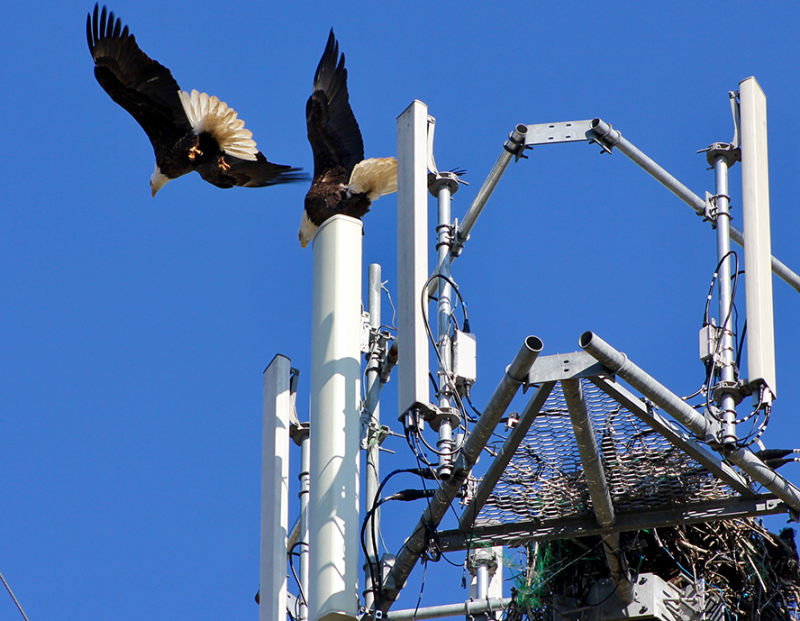New bald eagle family doesn’t mind Five Points chaos
A pair of promiscuous bald eagles has taken up residence at the epicenter of Cape Region traffic. High atop a communications tower standing in the grassy plot defined by the traffic jughandle next to the BP station, the eagles have built a nest - or squatted in a nest built previously by an osprey family. As if on cue for the Valentine’s Day holiday, the eagles have been courting one another: wheeling around in the sky overhead, perching alongside one another atop the tower, and making love – as birds do – next to their nest.
Rob Davis, who drives between his home in Lewes and his job for the county in Georgetown, passes through Five Points at least twice a day. He noticed the eagles atop the tower right around Christmas and alerted me to another form of new construction in the area.
Ralph Short, who walks the trail at the Villages of Five Points on a regular basis, hadn’t noticed the eagles. But when I pointed them out to him this week, he said they have taken over a former osprey’s nest. “The ospreys were nesting there before,” he said. “100 percent.”
Eagles are known for taking fish away from skillful ospreys. Stealing an existing osprey nest obviously isn’t beneath them.
The eagles’ new home stands more than 100 feet above the ground and gives them a straight sight line to the Villages of Five Points pond just across Savannah Road, which passes beneath them. Fish, waterfowl, seagulls and other critters at the pond – and at other ponds in a few-mile radius – offer feeding opportunities for the young family.
According to the National Fish and Wildlife Service, the Chesapeake Bay region where we live is home to one of the nation’s handful of significant bald eagle populations.
It takes four to five years for eaglets to mature to breeding age, and they can live 15 to 25 years. Big birds, their wings can span between five and eight feet. It takes those big wings to lift their eight- to 14-pound bodies – often with prey in their talons – off the ground.
The NFWS notes that eagles have “high nest fidelity” and will return year after year. They often dress their nests up along the way, which is why they have to find stable platforms. Starting with sticks two and three inches in diameter, and then adding smaller sticks and comfortable liners of moss, grass, plant stalks, seaweed and sod, eagles can bring the total weight of their abodes to more than 1,000 pounds. The nests measure four to six feet in diameter and up to three feet deep.
It doesn’t seem likely the nest will be cleared away anytime soon. Though their numbers have been rebounding since the great DDT decline that didn’t end until the 1970s, eagles are still protected by the federal Bald and Golden Eagle Protection Act of 1940. Tower maintenance crews are forbidden to disturb the eagles during their nesting and breeding season, which in this area can extend from late fall until midsummer when young eagles typically fledge.
Fines of up to $100,000 can be levied against those who threaten, kill, or disturb eagles.
Given the height of their tower above predators, and the long and protective arm of the law, the new family of Five Points eagles could be part of the traffic pattern there for many years.

























































